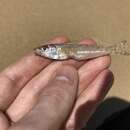Diagnostic Description
provided by Fishbase
Anterolateral extensions of swim bladder recurved posteriorly to reach level of vent. Base of pectoral fin with black spot, back and sides with dark blotches. The upper and lower blotches are frequently joined, at least posteriorly, the upper blotches are generally larger; the opercle is dull or with an inner dark blotch showing through. Coloration is similar to S. burrus and S. aeolus.
Diseases and Parasites
provided by Fishbase
Stictodora Infestation 3. Parasitic infestations (protozoa, worms, etc.)
Life Cycle
provided by Fishbase
They spawn several times each year (Ref. 26745).
Morphology
provided by Fishbase
Dorsal spines (total): 12 - 13; Dorsal soft rays (total): 19 - 21; Analspines: 2; Analsoft rays: 19 - 20; Vertebrae: 34 - 36
Trophic Strategy
provided by Fishbase
Occur on silty and muddy substrates in the deeper water of bays, but also frequenting the mouths of rivers, estuaries, and mangrove creeks. Juveniles abound in estuaries and shallow water during summer, moving deeper as they mature. Found inshore (Ref. 75154). They forage for burrowing or benthic animals by using their conical snout to plough through sand or mud (Ref. 6390). They change their dietary pattern as they grow larger (Ref. 6223).
Biology
provided by Fishbase
Occur on silty and muddy substrates in the deeper water of bays, but also frequenting the mouths of rivers, estuaries, and mangrove creeks. Juveniles abound in estuaries and shallow water during summer, moving deeper as they mature. Diet of juveniles consist largely of small crustaceans and that of the adult fish consist mainly of polychaete worms and bivalve mollusks. Oviparous (Ref. 205). Spawn throughout the year with peaks in Dec.-Feb. (Ref. 6390). Marketed fresh (Ref. 9987) and chilled (Ref. 6390).
Importance
provided by Fishbase
fisheries: minor commercial; aquaculture: experimental; gamefish: yes; price category: very high; price reliability: very questionable: based on ex-vessel price for species in this family

